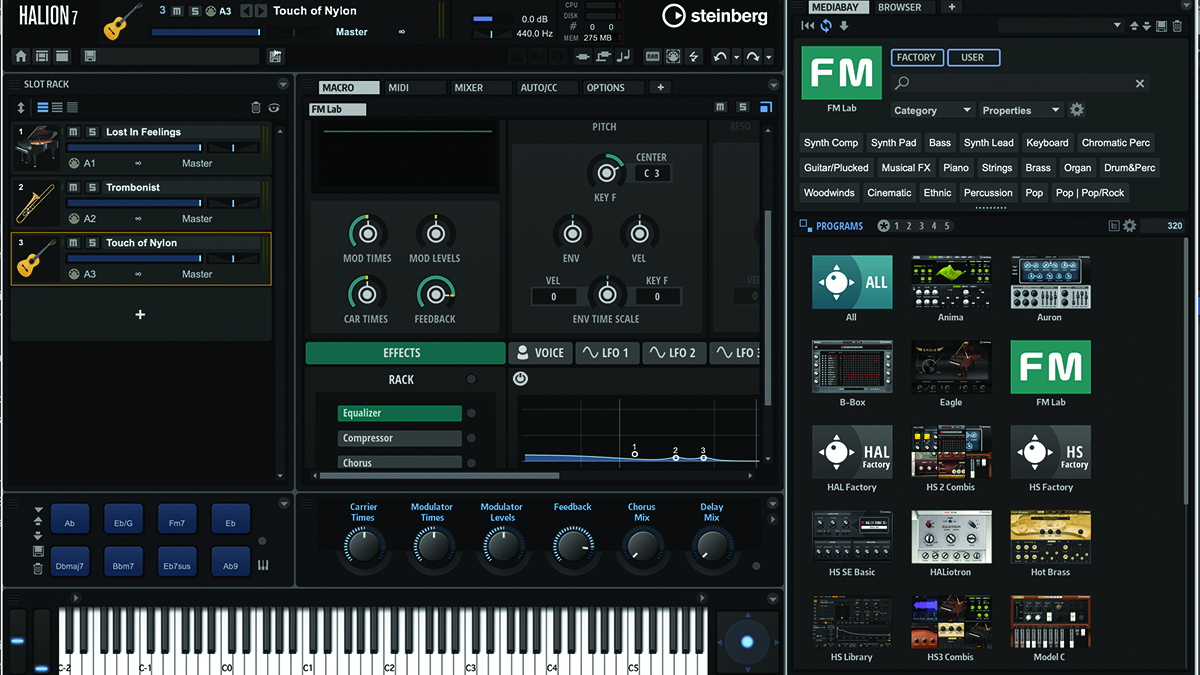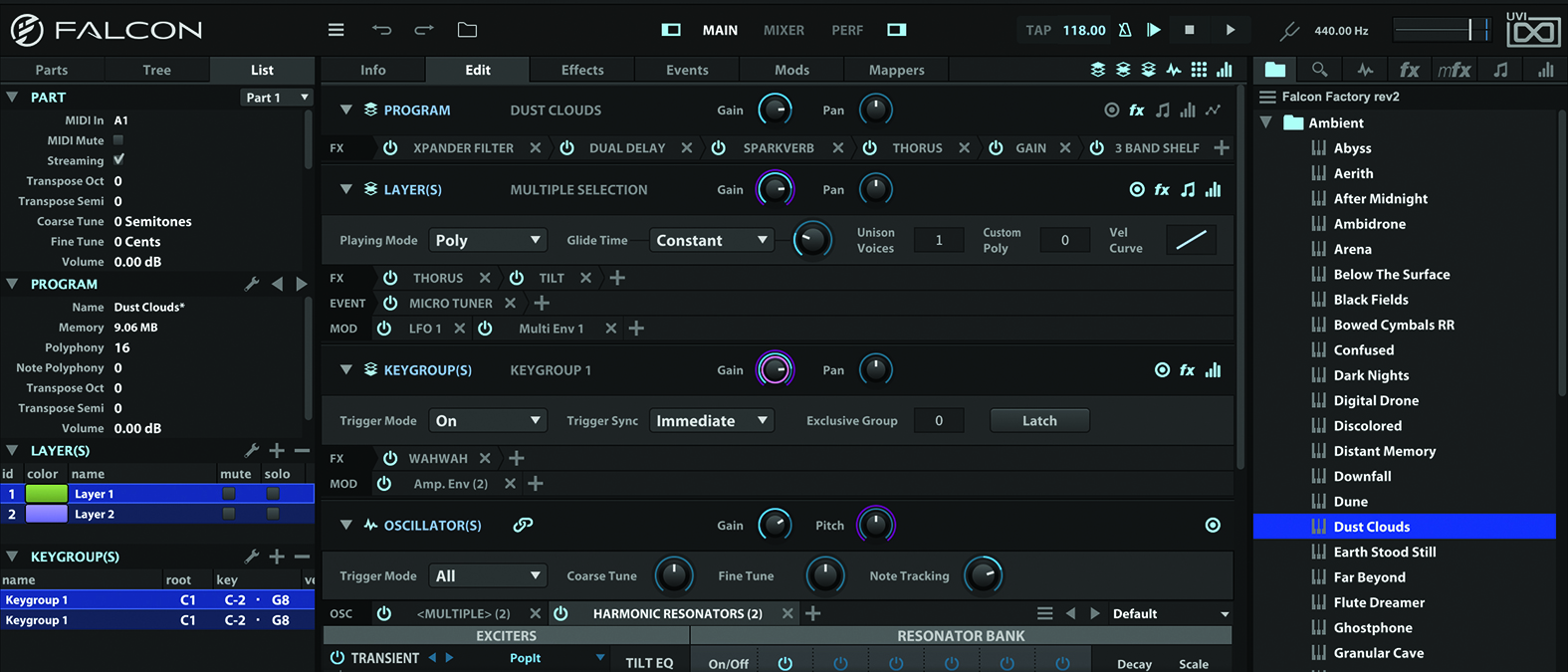MusicRadar Verdict
Of the few software titles that claim to do it all, Falcon is flying high. It was hard to see how UVI could improve it – but it has!
Pros
- +
An oscillator for everything.
- +
‘Modulate your modulations’ – exactly.
- +
We love the scripted processing system.
- +
Fantastic instrument presets.
Cons
- -
The sonic structure is not as intuitive as it could be.
- -
Vast and can be overwhelming.
- -
Crashed in Logic during our tests.
MusicRadar's got your back
UVI Falcon 3: What is it?
Every type of hardware synthesizer has now been emulated in software and Falcon 3 is pretty much every type of synthesizer under one roof. The nearest hardware comparisons are perhaps the all-conquering workstation synths from the likes of Yamaha and Korg. They do everything; but without the physical constraints of hardware, Falcon has always done even more.
Like those hardware giants, Falcon is multitimbral – that is, you can play different sounds from its many different engines at the same time or as separate parts of a song. And it’s all handled with a fantastic semi-modular approach that, in spite of the less-than-simple UI, is certainly a lot more straightforward than it should be, given the huge scope on offer.

UVI Falcon 3: Performance and verdict
The core idea is to expand on the different synthesis and sampling oscillators with effects, modulation and a series of customisable scripted generators and processors. And this means that those multitimbral parts have access to pretty much every sound type ever invented. Of course version 3 has more of everything, with 20 oscillators (about which we expand on below) over 100 effects, around 70 script processors and 13 modulators.

• Steinberg HALion 7
Another huge workstation that delivers everything you need. Choose one. Both would be overkill.
• Spectrasonics Omnisphere 2
The king of synths is still just that, but its price has crept up.
There’s also a sizable (although not exactly over-endowed) library of preset content to load in and manipulate, with 24 expansion packs available (two of which have been added at v3).
The layering and component structure in Falcon is important to get your head around. You start with assigning an oscillator to a key range as a Keygroup. This then becomes a Layer when you assign effects, modulation (LFOs, envelopes etc) and those scripted MIDI events. Programs made up of different Layers or Keygroups then make up that Multi part where each different Program can be layered or mixed as separate song parts.
The script system has always been a highlight in Falcon, including devices like arpeggiators, sequencers, tuners and chord generators. New in v3 are Node Arp, an interesting matrix sequencer with active and passive ‘nodes’ that can bring variety and movement to an evolving sound; Motion Grid, a similar grid sequencer but with more direction and scale options; and Snowflakes, a 12-note sequencer that adds a staccato-like effect to sustained notes.
New effects are also welcome, including Opal, a great optical compressor with seven emulations of real hardware to choose from; Ladder, a simple but surprisingly dramatic East Coast filter; Dispersor, another simple-looking effect but a capable transient shaper; and finally Harmonic Resonator which is a highlight, a six-band resonator EQ with lots of options to shape your sound.
Want all the hottest music and gear news, reviews, deals, features and more, direct to your inbox? Sign up here.

Falcon’s core
At the heart of Falcon are the oscillators that allow it to create such a diverse range of sounds. You get VA (Analog and Analog Stack), four-operator FM, Wavetable, Additive and Drum Synthesis plus physical modelling in the form of Pluck. Sampling engines include Sample, Slice and Stretch, and several created by French research institute IRCAM like Granular, Scrub and Stretch.
Newcomers in v3 are VOSIM which is described as ‘a tribute to vintage vocal synthesis’ and includes both a Formant mode and Phonem mode with vowel oscillation; Bowed String for detailed emulation of both an instrument bow and its strings with lots of parameters to fine tune for each; and finally Harmonic Resonators which has three sources (transient, texture, and noise) which can be mixed and then go through a 6-channel resonator bank (as shown above). These complete a huge and varied set of oscillators; indeed it’s hard to know what UVI could possibly add in future versions.
Does this Falcon fly?
As a sound design tool, there are few other applications that get close to Falcon 3. It has so much in terms of variety of oscillators, effects and modulation that there’s very little that it can’t handle and help you create. The modulation and scripted processors take it above and beyond, allowing for evolving sounds, huge sequencing options and melody creation in many styles and scales.
There are loyal Falcon owners out there who give one another knowing looks – once you know, you know
Really it’s whether this ‘one stop shop for everything’ approach is for you. There are many loyal Falcon owners out there who give one another that knowing look – once you know, you know. But you might be someone who prefers to put together your own bespoke set of plugins to make your own personal sound design setup. The truth is, though, you can do that in Falcon too! We did experience a couple of worrying crashes in Logic, but overall Falcon 3 is still an immense sonic force, all under one roof.
MusicRadar verdict: Of the few software titles that claim to do it all, Falcon is flying high. It was hard to see how UVI could improve it – but it has!
UVI Falcon 3: The web says
"The limitless sound design options offered by Falcon result in a formidable collection of factory presets, packed to the gunnels with classic synth staples and inspirational, ear-popping sounds that few other synths could create."
MusicTech
UVI Falcon 3: Hands-on demos
UVI
Mattias Holmgren
SumnSumnSumn HTK
UVI Falcon 3: Specifications
- Windows (10+), Mac (OS X 10.14+) on Intel or ARM M1. Standalone, VST, VST3, AU, AAX.
- CONTACT: UVI
Andy has been writing about music production and technology for 30 years having started out on Music Technology magazine back in 1992. He has edited the magazines Future Music, Keyboard Review, MusicTech and Computer Music, which he helped launch back in 1998. He owns way too many synthesizers.




